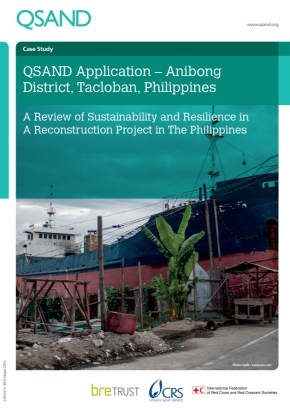Reconstruction following typhoon Haiyan
Super Typhoon Haiyan, known locally as Yolanda, struck the Philippines in November 2013. It is considered one of the strongest typhoons ever recorded with Category 5-equivalent winds and five to six-meter storm surges at landfall. It left neighbourhoods and infrastructure in ruins with over 1.1 million houses destroyed or damaged and over 12 million people affected.
Among the most devastated areas was the coastal district of Anibong in Tacloban, on Leyte island, where the super typhoon washed away or destroyed the vast majority of houses and local infrastructure. CRS, and its local partner Caritas Philippines, have been responding to the disaster since November 2013. CRS aimed to help 100,000 families in Leyte with the use of “build back safer” techniques to increase community resilience and support livelihoods in the area.
In the early stages of the Anibong Resettlement Project CRS used QSAND (Quantifying Sustainability in the Aftermath of Natural Disasters) to support their sustainability and resilience planning and implementation activities. QSAND was used to review and help identify any gaps in their programme with the aim of enhancing activities where appropriate. This took the form of a preliminary QSAND assessment during which all QSAND assessment and cross cutting issues were reviewed and considered.
Yetunde Abdul, QSAND Programme Manager said: “Hearing from CRS that QSAND prompted thinking and discussion about enhancement of existing or consideration of new approaches exemplifies how QSAND can benefit the development of reconstruction projects.”
The outputs of the QSAND application in the project have been captured in a case study now available on the QSAND website here.
Tulio Mateo, CRS Technical Advisor for Shelter and Settlements said: “The Haiyan response makes me feel very proud for many reasons. We facilitated an integrated recovery process for thousands of people, giving them options to choose from. This sounds easy but it is not. It is a process that takes time and patience, and not all organizations take the time to do it, and we did.”
The QSAND Team was pleased to contribute towards efforts to enhance sustainability and resilience in the Typhoon Haiyan response.
The article was written by George Foden was originally published on 11 February 2019 on the BRE Buzz website.
--BRE Buzz
[edit] Related articles on Designing Buildings Wiki
- BRE Buzz.
- BRE Buzz articles.
- BREEAM.
- Building Research Establishment.
- Enhancing community energy resilience, QSAND and Loughborough University Research collaboration.
- Helping achieve the UN's Sustainable Development Goals.
- Helping communities recover from disasters and protecting them before they occur.
- How to rebuild using the debris from disasters.
- Managing and responding to disaster.
- QSAND.
- QSAND and the Sustainable Development Goals.
- QSAND application in Nepal.
Featured articles and news
RTPI leader to become new CIOB Chief Executive Officer
Dr Victoria Hills MRTPI, FICE to take over after Caroline Gumble’s departure.
Social and affordable housing, a long term plan for delivery
The “Delivering a Decade of Renewal for Social and Affordable Housing” strategy sets out future path.
A change to adoptive architecture
Effects of global weather warming on architectural detailing, material choice and human interaction.
The proposed publicly owned and backed subsidiary of Homes England, to facilitate new homes.
How big is the problem and what can we do to mitigate the effects?
Overheating guidance and tools for building designers
A number of cool guides to help with the heat.
The UK's Modern Industrial Strategy: A 10 year plan
Previous consultation criticism, current key elements and general support with some persisting reservations.
Building Safety Regulator reforms
New roles, new staff and a new fast track service pave the way for a single construction regulator.
Architectural Technologist CPDs and Communications
CIAT CPD… and how you can do it!
Cooling centres and cool spaces
Managing extreme heat in cities by directing the public to places for heat stress relief and water sources.
Winter gardens: A brief history and warm variations
Extending the season with glass in different forms and terms.
Restoring Great Yarmouth's Winter Gardens
Transforming one of the least sustainable constructions imaginable.
Construction Skills Mission Board launch sector drive
Newly formed government and industry collaboration set strategy for recruiting an additional 100,000 construction workers a year.
New Architects Code comes into effect in September 2025
ARB Architects Code of Conduct and Practice available with ongoing consultation regarding guidance.
Welsh Skills Body (Medr) launches ambitious plan
The new skills body brings together funding and regulation of tertiary education and research for the devolved nation.
Paul Gandy FCIOB announced as next CIOB President
Former Tilbury Douglas CEO takes helm.
UK Infrastructure: A 10 Year Strategy. In brief with reactions
With the National Infrastructure and Service Transformation Authority (NISTA).
























